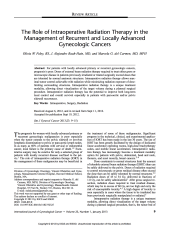Abstract
For patients with locally advanced primary or recurrent gynecologic cancers, prognosis is poor. doses of external beam radiation therapy required to treat either gross or microscopic disease in patients previously irradiated or treated surgically surgically exceed doses that are tolerated by normal anatomic structures. Intraoperative radiation therapy allows maximal tumor control achievable with radiation while minimizing radiation exposure of dose limiting surrounding structures. Intraoperative radiation therapy is a unique treatment modality, allowing direct visualization of the target volume during a planned surgical procedure. Intraoperative radiation therapy has the potential to improve both long-term local control and overall survival especially in patients with para-arortic and/or pelvic sidewall recurrences.
Conclusions
For patients with locally advanced primary or recurrent gynecologic cancers, prognosis is poor. Doses of EBRT required to treat either gross or microscopic disease in patients previously irradiated or treated surgically exceed doses that are tolerated by normal anatomic structures. Intraoperative radiation therapy can be part of the treatment armamentarium, allowing maximal tumor control achievable with radiation while minimizing radiation exposure of dose-limiting surrounding structures. Intraoperative radiation therapy has the potential to improve both long-term local control and overall survival in patients with para-aortic and/or pelvic sidewall recurrences. The most encouraging results have been documented in cases where IORT is delivered to microscopic residual beds after surgical resection.
The experience with IORT further validates the importance of optical surgical resection.5 Higher 5-year diseasefree and overall survival rates have been reported for patients treated with IORTwho had microscopic disease after surgical resection when compared with patients who had gross residual disease left in situ. Review of institutional experiences with IORT may result in establishment of guidelines for appropriate patient selection. These criteria may be helpful in guiding the design of clinical trials in the future. The construction, execution, and evaluation of clinical trials are mandatory to adequately assess the role of IORT in the management of patients with gynecologic cancers.
